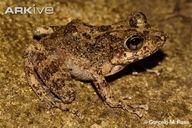|
Description
M 37-38 mm. Tibiotarsal articulation reaches between eye and nostril. Hand without webbing, foot webbing 1(1), 2i(2.5), 2e(0.75), 3i(2), 3e(1.25), 4i(2.5), 4e(2.25), 5(1). Dorsal skin granular. Colour dorsally brown with indistinct darker markings. Venter whitish, throat dark except for a light median stripe. Males with a blackish paired subgular vocal sac.
Similar species: At Isalo, the species is easily confused with G. azzurrae. Morphologically similar specimens from Bemaraha are genetically strongly differentiated and belong to a different, undescribed species. Distribution and Habitat
Country distribution from AmphibiaWeb's database: Madagascar
Isalo (Namazaha valley).
Observed at elevations up to 200-800m (Glaw et. al 2008).
Life History, Abundance, Activity, and Special Behaviors
Habits: Calling males were found along a stream in relict forest, sitting on woods and rocks about 50 cm above the ground. Tadpoles assigned to this species were found in the streams. Metamorphosing juveniles measured 13 mm.
Calls: A series of loud, screaming unharmonious notes, reminding a high-pitched call of a crow.
Trends and Threats
This species is listed as endangered because its Extent of Occurrence is less than 5,000 km2, it is known from fewer than five locations, and the extent of its dry forest habitat in west-central Madagascar is declining. It occurs in Parc National de Isalo, although not all of the Isalo Massif is protected (Glaw et. al 2008). Possible reasons for amphibian decline General habitat alteration and loss
Habitat modification from deforestation, or logging related activities
Intensified agriculture or grazing
Urbanization
Comments
Taken with permission from Glaw and Vences (2007).
References
Glaw, F., Raxworthy, C., Andreone, F., Vences, M., and Rabibisoa, N.H.C. (2008). Gephyromantis corvus. In: IUCN 2008. 2008 IUCN Red List of Threatened Species. www.iucnredlist.org. Downloaded on 18 March 2009.
Glaw, F., and Vences, M. (2007). Field Guide to the Amphibians and Reptiles of Madagascar. Third Edition. Vences and Glaw Verlag, Köln.
Originally submitted by: Frank Glaw and Miguel Vences (first posted 2000-11-27)
Edited by: Catherine Aguilar (2009-04-07)Species Account Citation: AmphibiaWeb 2009 Gephyromantis corvus <https://amphibiaweb.org/species/4589> University of California, Berkeley, CA, USA. Accessed Apr 19, 2025.
Feedback or comments about this page.
Citation: AmphibiaWeb. 2025. <https://amphibiaweb.org> University of California, Berkeley, CA, USA. Accessed 19 Apr 2025.
AmphibiaWeb's policy on data use.
| 